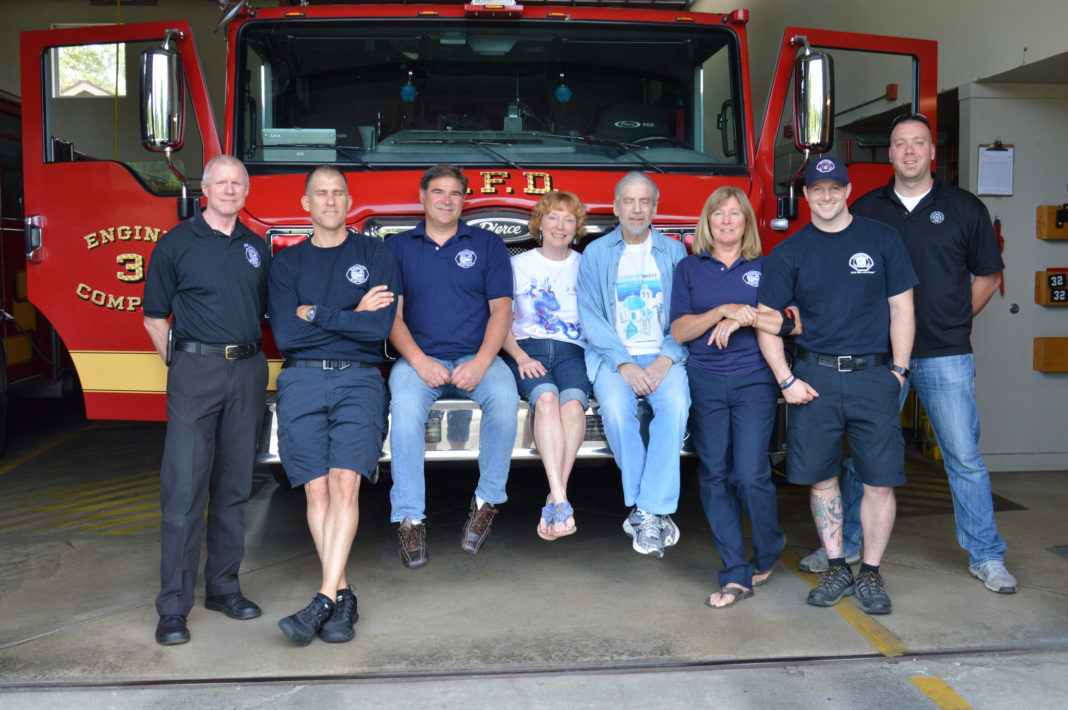It could have ended so differently. Gloria Russell was with her husband, Don, when he suffered a heart attack and went into full cardiac arrest on April 6, 2017. He was dead. And then he wasn’t. On Friday, June 2, Gloria and Don had a celebratory dinner with the firefighters and paramedics who, along with Gloria, saved his life.
 Engine 03 from Olympia’s east side and Medic 5 out of Tumwater, which happened to be in the area, both responded to the call. Olympia Fire Department (OFD) Assistant Chief Rob Bradley, who is the Fire Marshall for the city, was also in the area and responded to the call. The firefighters, all trained Emergency Medical Technicians (EMT), provided Basic Life Support while the paramedics provided Advanced Life Support.
Engine 03 from Olympia’s east side and Medic 5 out of Tumwater, which happened to be in the area, both responded to the call. Olympia Fire Department (OFD) Assistant Chief Rob Bradley, who is the Fire Marshall for the city, was also in the area and responded to the call. The firefighters, all trained Emergency Medical Technicians (EMT), provided Basic Life Support while the paramedics provided Advanced Life Support.
Making a save is always a great thing, but the firefighters and paramedics know that they are only part of the reason Don was able to walk out the hospital.
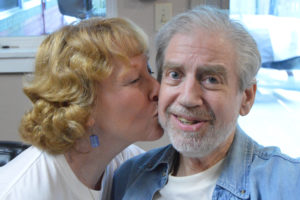
Gloria did two very important things when she witnessed her husband’s cardiac arrest. She called 911, and she performed CPR.
Thurston County has been monitoring cardiac arrest events since 2005. It’s Cori Spotts’ job to study the statistics involved. She and others who crunch the data know one thing is certain: Early CPR is critical to survival. “CPR performed by a lay person before the fire department arrives significantly increases the chance of survival,” she says.
“High Performance” CPR performed by first responders is also key. This method assigns specific jobs to every crew member on every shift. One person is in charge of chest compressions and ventilation. Another is in charge of suction and the oxygen administration. Another is the timer, calling for periodic rhythm analysis and rotation of those performing compressions. On the scene, there is no scrambling to figure out who is going to do what.
Thurston County began High Performance CPR training county wide in 2009. It’s the primary reason the OFD and Tumwater units were able to work together so well. Coming from different departments wasn’t a problem says OFD Captain Jim Brown. “It really tells a great story about partnership. We are able to work together cohesively because we run calls the same way.” The training is consistent, and everyone knows what their roles are. The firefighters run the event while the paramedics provide advanced medical treatment. A call anywhere in the county will follow the same protocols regardless of which department responds.
Kurt Hardin, director of Thurston County Medic One (TCMO) says the firefighters – the Emergency Medical Technicians – are the backbone of the system. Because they’re running the call, it frees the paramedics up to do what they need to do.
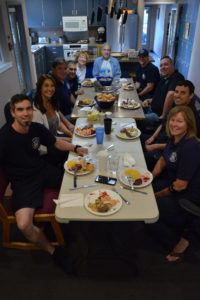
And then there is the citizen responder. “Gloria is the real hero here,” says AC Bates, one of the paramedics on the call. “All the science is showing that bystander CPR is critical. Her early and quality CPR is what did the greatest good. We didn’t want to screw up her good work.”
This is the reason Medic One and all Thurston County Fire Departments and districts are making a concentrated push for community CPR training and awareness. CPR is now a requirement for high school graduation, so fire departments are doing a lot of outreach with school districts. “We (OFD) taught CPR to 200 kids yesterday (June 5) at Capital High School,” says Brown. “We teach hands-only, which is the standard for community CPR. It’s ‘push hard, push fast’ and keep going until the fire department gets there. There’s no mouth-to-mouth. It’s CPR awareness, not a certification course.”
Medic One is also dedicated to community outreach and training. There is no charge, and businesses and civic groups can arrange for classes. American Heart Association certification and awareness class are both available. Last year approximately 5,000 people received training, and they’re hoping to up those numbers for 2017.
This push for community education and the adoption of High Performance CPR is working, too. The City of Olympia has one of the highest cardiac arrest survival rates in the nation. Using Utstein Criteria for consistency in measurement, in 2016, 58% of the cardiac arrest runs made by the OFD to witnessed cardiac arrests had a successful outcome. Thurston County as a whole was 47%. For comparison, many large cities have numbers in the single digits.
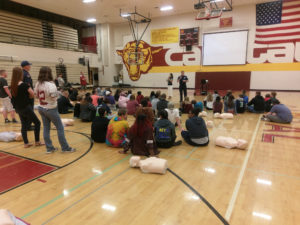
“It’s starts with the citizen calling 911 and starting CPR,” says Anna Lee Drewry, BLS Training Program Manager for TCMO, “They may be assisted by 911 (operators) who play an integral part, not just by dispatching Fire and EMS, but by giving directions over the phone.”
Gloria knows about that. She is a trained nurse, but nothing prepares a person for having to perform CPR on a loved one. “The 911 dispatcher counted compressions for me, and I didn’t feel so alone,” she says. Then the firefighters and paramedics arrived and were “… like angels descending,” she says with a giant smile.
Gloria performed chest compressions on her husband for four minutes before being relieved. Firefighters continued High Performance CPR for another three or four minutes before paramedics used a defibrillator on Don for the first time. They had a rhythm for a minute or two then lost him again. After a second shock by the defibrillator, he was stable enough to transport to Providence St. Peter Hospital.
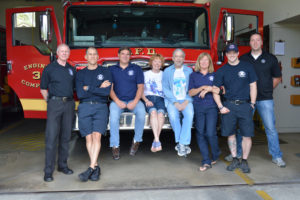
Don doesn’t remember anything about his heart attack. All he knows is that he woke up at the hospital a day later with a tube down his throat. He remained in the hospital for a week before he was well enough to undergo quadruple bypass surgery. He went home with his wife on April 19, just two weeks after going into full cardiac arrest.
“I’m a grateful person,” he says. That’s why he and his wife wanted to meet their heroes. Their heroes wanted to meet them, too. It’s not every day that a full arrest walks into the station to say thank you. “This is the first time in 27 years,” says firefighter Jerry Miller.
For the OFD and their Medic One counterparts, it’s always a good thing to put a face on a positive statistic.







































